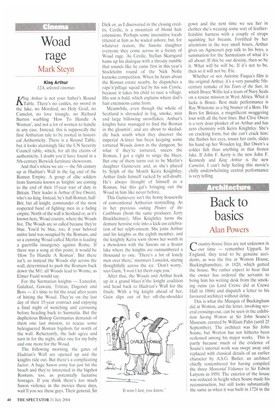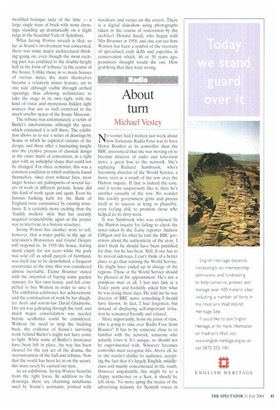Back to basics
Alan Powers
(-1 ountry-house fires are not unknown in
our time — remember Uppark. In England, they tend to be genuine accidents, as was the fire at Wotton House, Buckinghamshire, in 1820, which gutted the house. We rather expect to hear that the owner has ordered the servants to bring him his writing desk from the smoking ruins (as Lord Crewe did at Crewe Hall in 1866) and dispatch a letter to his favoured architect without delay.
This is what the Marquis of Buckingham did at Wotton, and the letter, involving several crossings-out, can be seen in the exhibition Saving Wotton at Sir John Soane's Museum. curated by William Palin (until 25 September). The architect was Sir John Soane, but Wotton has not hitherto been reckoned among his major works. This is partly because much of the evidence of Soane's internal work was swept away and replaced with classical details of an earlier character by A.S.G. Butler, an architect chiefly remembered for having compiled the three Memorial Volumes to Sir Edwin Lutyens in 1950. The exterior of the house was reduced in height when Soane made his reconstruction, but still looks substantially the same as when it was built in 1724 in the
modified baroque taste of the time — a large single mass of brick with stone dressings, standing up dramatically on a slight ridge in the beautiful Vale of Aylesbury.
What Saving Wotton reveals is that, so far as Soane's involvement was concerned, there was some major architectural thinking going on, even though the most exciting part was confined to the double-height hall in the form of 'tribuna' in the centre of the house. Unlike those in so many houses of various dates, the stairs themselves became a relatively minor feature, set to one side although visible through arched openings, thus allowing architecture to take the stage in its own right, with the kind of vistas and mysterious hidden light sources that are so well contrived in the much smaller space of the Soane Museum.
The tribuna was unfortunately a victim of Butler's interventions, although the space which contained it is still there. The exhibition allows us to see a series of drawings by Soane in which he explored variants of the design, and these offer a fascinating insight into the creative process of classical design at the outer limits of convention, in a tight spot with an unhelpful shape that could not be changed. For three centuries, this was a common condition in which architects found themselves, since even without fires, most larger houses are palimpsests of several layers of work in different periods. Soane did this kind of work again and again. Even his famous banking halls for the Bank of England were constrained by existing structures. It is certainly more exciting than the 'frankly modern' style that has recently acquired respectability again as the proper way to intervene in a historic structure.
Saving Wotton has another story to tell, however, that a wider public in the age of television's Restoration and Grand Designs will respond to. In 1958 the house, having stood empty for ten years while the park was sold off as small parcels of farmland, was itself due to be demolished, a frequent occurrence at the time that was considered almost inevitable. Elaine Brunner visited with the intention of buying some garden statuary for her own house, and felt compelled to buy Wotton in order to save it. The exhibition celebrates her achievement, and the continuation of work by her daughter Avril and son-in-law David Gladstone. Dry rot was galloping through the roof, and much major consolidation was needed before aesthetics could be considered. Without the need to strip the building back, the evidence of Soane's surviving work behind Butler's might not have come to light. While some of Butler's doorcases have been left in place, the way has been cleared for the last act of the drama, the reconstruction of the hall and tribuna. Now that the world has been let in on the secret, this must surely be carried out next.
As an exhibition, Saving Wotton benefits from the tight focus. In addition to the drawings, there are charming notebooks used by Soane's assistants, printed with woodcuts and verses on the covers. There is a digital slideshow using photographs taken in the course of restoration by the architect Donald Insall, who began with Mrs Brunner in 1958, and one can see how Wotton has been a symbol of the recovery of specialised craft skills and expertise in conservation which, 40 or 50 years ago, pessimists thought would die out. How gratifying that they were wrong.



























































 Previous page
Previous page